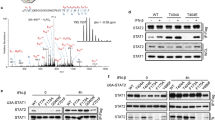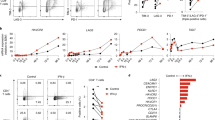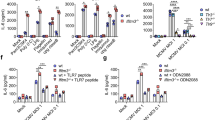Abstract
Induction of high systemic levels of type 1 interferons (IFNs) IFN-α and IFN-β is a hallmark of many viral infections. In addition to their potent antiviral effects, these cytokines mediate a number of immunoregulatory functions and can promote IFN-γ expression in T cells. However, during viral infections of mice IFN-γ production is not always observed at the same time as systemic IFN-α/β production and when, elicited at these times, is IFN-α/β–independent. We demonstrate that type 1 interferons not only fail to induce, but also act to inhibit, IFN-γ expression by both NK and T cells. The mechanism of inhibition is dependent upon the IFN-α/β receptor and the signal transducer and activator of transcription 1 (STAT1). In the absence of STAT1, not only are the IFN-α/β–mediated inhibitory effects completely abrogated, but the cytokines themselves can induce IFN-γ expression. These results indicate that endogenous biochemical pathways are in place to negatively regulate NK and T cell IFN-γ expression elicited by IFN-α/β or other stimuli, at times of innate responses to viral infections. They also show that type 1 interferon signaling can occur through STAT1-dependent and independent mechanisms and suggest that efficient induction of IFN-γ expression by IFN-α/β requires STAT1 regulation. Such immunoregulatory pathways may be critical for shaping the endogenous innate and virus-specific adaptive immune responses to viral infections.
This is a preview of subscription content, access via your institution
Access options
Subscribe to this journal
Receive 12 print issues and online access
$209.00 per year
only $17.42 per issue
Buy this article
- Purchase on Springer Link
- Instant access to full article PDF
Prices may be subject to local taxes which are calculated during checkout







Similar content being viewed by others
References
Biron, C. A., Nguyen, K. B., Pien, G. C., Cousens, L. P. & Salazar-Mather, T. P. Natural killer cells in antiviral defense: function and regulation by innate cytokines. Annu. Rev. Immunol. 17, 189–220 (1999).
Pfeffer, L. M. et al. 1998. Biological properties of recombinant α-interferons: 40th anniversary of the discovery of interferons. Cancer Res. 58, 2489–2499 (1998).
Biron, C. A. Role of early cytokines, including α and β interferons (IFN-α/β), in innate and adaptive immune responses to viral infections. Semin. Immunol. 5, 383–390 (1998).
Biron, C. A. Initial and innate responses to viral infections – pattern setting in immunity or disease. Curr. Opin. Microbiol. 2, 374–381 (1999).
Klimstra, W. B. et al. Infection of neonatal mice with sindbis virus results in a systemic inflammatory response syndrome. J. Virol. 73, 10387–10398 (1999).
Orange, J. S. & Biron, C. A. Characterization of early IL-12, IFN-α/β, and TNF effects on antiviral state and NK cell responses during murine cytomegalovirus infection. J. Immunol. 156, 4746–4756 (1996).
Tough, D. F., Borrow, P. & J. Sprent . Induction of bystander T cell proliferation by viruses and type I interferon in vivo. Science 272, 1947–1950 (1996).
Marrack, P., Kappler, J. & T. Mitchell . Type I interferons keep activated T cells alive. J. Exp. Med. 189, 521–530 (1999).
Orange, J. S., Wang, B., Terhorst, C. & Biron, C. A. Requirement for natural killer cell-produced interferon gamma in defense against murine cytomegalovirus infection and enhancement of this defense pathway by interleukin 12 administration. J. Exp. Med. 182, 1045–1056 (1995).
Orange, J. S. & Biron, C. A. An absolute and restricted requirement for IL-12 in natural killer cell IFN-gamma production and antiviral defense. Studies of natural killer and T cell responses in contrasting viral infections. J. Immunol. 156, 1138–1142 (1996).
Ruzek, M. C., Miller, A. H., Opal, S. M., Pearce, B. D. & Biron, C. A. Characterization of early cytokine responses and an interleukin (IL)-6-dependent pathway of endogenous glucocorticoid induction during murine cytomegalovirus infection. J. Exp. Med. 185, 1185–1192 (1997).
Pien, G. C. & Biron, C. A. Compartmental differences in NK cell responsiveness to IL-12 during lymphocytic choriomeningitis virus (LCMV) infection. J. Immunol. 164, 994–1001 (2000).
Cousens, L.P., Orange, J. S., Su, H. C. & Biron, C.A. Interferon-α/β inhibition of interleukin 12 and interferon-γ production in vitro and endogenously during viral infection. Proc. Natl Acad. Sci. USA 94, 634–639 (1997).
Rogge, L. et al. Selective expression of an interleukin-12 receptor component by human T helper 1 cells. J. Exp. Med. 185, 825–831 (1997).
Rogge, L. et al. The role of Stat4 in species-specific regulation of Th cell development by type I IFNs. J. Immunol. 161, 6567–6574 (1998).
Durbin, J. E., Hackenmiller, R., Simon, M. C. & Levy, D. E. Targeted disruption of the mouse Stat1 gene results in compromised innate immunity to viral disease. Cell 84, 443–450 (1996).
Meraz, M. A. et al. Targeted disruption of the Stat1 gene in mice reveals unexpected physiologic specificity in the JAK-STAT signaling pathway. Cell 84, 431–442 (1996).
Ramana, C. V. et al. Regulation of c-myc expression by IFN-gamma through Stat1-dependent and -independent pathways. EMBO J. 19, 263–272 (2000)
Wang, Y., Wu, T. R., Cai, S., Welte, T. & Y. E. Chin . Stat1 as a component of TNFα receptor 1-TRADD signaling complex to inhibit NF-κB activation. Mol. Cell Biol. 20, 4505–4512 (2000).
Xu, X., Sun, Y. L. & Hoey, T. Cooperative DNA binding and sequence-selective recognition conferred by the STAT amino-terminal domain. Science 273, 794–797 (1996).
Haque, S. J., Flati, V., Deb, A. & Williams, B. R. Roles of protein-tyrosine phosphatases in Stat1 α-mediated cell signaling. J. Biol. Chem. 270, 25709–25714 (1995).
Lee, C. K., Bluyssen, H. A. & Levy, D. E. Regulation of interferon-alpha responsiveness by the duration of Janus kinase activity. J. Biol. Chem. 72, 21872–21877 (1997).
You, M., Yu, D. H. & Feng, G. S. Shp-2 tyrosine phosphatase functions as a negative regulator of the interferon-stimulated Jak/STAT pathway. Mol. Cell Biol. 19, 2416–2424 (1999).
Sakamoto, H. et al. A Janus kinase inhibitor, JAB, is an interferon-gamma-inducible gene and confers resistance to interferons. Blood 92, 1668–1676 (1998).
Song, M. M. & Shuai, K. The suppressor of cytokine signaling (SOCS) 1 and SOCS3 but not SOCS2 proteins inhibit interferon-mediated antiviral and antiproliferative activities. J. Biol. Chem. 273, 35056–35062 (1998).
Marine, J. C. et al. SOCS1 deficiency causes a lymphocyte-dependent perinatal lethality. Cell 98, 609–616 (1999).
Alexander, W. S. et al. SOCS1 is a critical inhibitor of interferon gamma signaling and prevents the potentially fatal neonatal actions of this cytokine. Cell 98, 597–608 (1999).
Haspel, R. L. & Darnell, J. E. Jr. A nuclear protein tyrosine phosphatase is required for the inactivation of Stat1. Proc. Natl Acad. Sci. USA 96, 10188–10193 (1999).
Teague, T. K. et al. Activation-induced Inhibition of Interleukin 6-mediated T cell survival and signal transducer and activator of transcription 1 signaling. J. Exp. Med. 191, 915–926 (2000).
Cousens, L. P. et al. Two roads diverged: interferon α/β- and interleukin 12-mediated pathways in promoting T cell interferon γ responses during viral infection. J. Exp. Med. 189, 1315–1328 (1999).
Nguyen, K. B. & Biron, C. A. Synergism for cytokine-mediated disease during concurrent endotoxin and viral challenges: roles for NK and T cell IFN-gamma production. J. Immunol. 162, 5238–5246 (1999).
Orange, J. S. et al. Mechanism of interleukin 12-mediated toxicities during experimental viral infections: role of tumor necrosis factor and glucocorticoids. J. Exp. Med. 181, 901–914 (1995).
Yoshida, R., Murray, H. W. & C. F. Nathan . Agonist and antagonist effects of interferon α and β on activation of human macrophages. Two classes of interferon γ receptors and blockade of the high-affinity sites by interferon alpha or beta. J. Exp. Med. 167, 1171–1185 (1988).
Politis, A. D., Sivo, J., Driggers, P. H., Ozato, K. & S. N. Vogel. Modulation of interferon consensus sequence binding protein mRNA in murine peritoneal macrophages. Induction by IFN-γ and down-regulation by IFN-α, dexamethasone, and protein kinase inhibitors. J. Immunol. 148, 801–807 (1992).
Gallimore, A. et al. Induction and exhaustion of lymphocytic choriomeningitis virus-specific cytotoxic T lymphocytes visualized using soluble tetrameric major histocompatibility complex class I-peptide complexes. J. Exp. Med. 187, 1383–1393 (1998).
Liu, Y. & C. A. Janeway, Jr. Interferon gamma plays a critical role in induced cell death of effector T cell: a possible third mechanism of self-tolerance. J. Exp. Med. 172, 1735–1739 (1990).
Muller, U. et al. Functional role of type I and type II interferons in antiviral defense. Science 264, 1918–1921 (1994).
Brunda, M. J. & Rosenbaum, D. Modulation of murine natural killer cell activity in vitro and in vivo by recombinant human interferons. Cancer Res. 44, 597–601 (1984).
Wu, C. Y., Wang, K., McDyer, J. F. & R. A. Seder . Prostaglandin E2 and dexamethasone inhibit IL-12 receptor expression and IL-12 responsiveness. J. Immunol. 161, 2723–2730 (1998).
Nishikomori, R., Ehrhardt, R. O. & W. Strober. T helper type 2 cell differentiation occurs in the presence of interleukin 12 receptor β2 chain expression and signaling. J. Exp. Med. 191, 847–858 (2000).
Acknowledgements
We thank Stacey Carlton, Marc Dalod, Ryuta Nishikomori, Philipp Osterloh, Melanie Ruzek, and Thais Salazar-Mather for their help with experiments and/or stimulating discussions; Eugene Chin for careful reading of the manuscript; and Michael Brunda, Ion Gresser, Phil Scott, Robert Seder, Warren Strober, and Giorgio Trinchieri, for valuable gifts of reagents. This work was supported by grants R01-CA41268 and T32-ES07272 from the National Institutes of Health, and by a pre-doctoral fellowship from HHMI.
Author information
Authors and Affiliations
Corresponding author
Rights and permissions
About this article
Cite this article
Nguyen, K., Cousens, L., Doughty, L. et al. Interferon α/β-mediated inhibition and promotion of interferon γ: STAT1 resolves a paradox. Nat Immunol 1, 70–76 (2000). https://doi.org/10.1038/76940
Received:
Accepted:
Issue Date:
DOI: https://doi.org/10.1038/76940
This article is cited by
-
Gas6 induces inflammation and reduces plaque burden but worsens behavior in a sex-dependent manner in the APP/PS1 model of Alzheimer’s disease
Journal of Neuroinflammation (2022)
-
Deconvoluting global cytokine signaling networks in natural killer cells
Nature Immunology (2021)
-
Loss of type I IFN responsiveness impairs natural killer cell antitumor activity in breast cancer
Cancer Immunology, Immunotherapy (2021)
-
Inherited PD-1 deficiency underlies tuberculosis and autoimmunity in a child
Nature Medicine (2021)
-
The TLR9 agonist MGN1703 triggers a potent type I interferon response in the sigmoid colon
Mucosal Immunology (2018)



